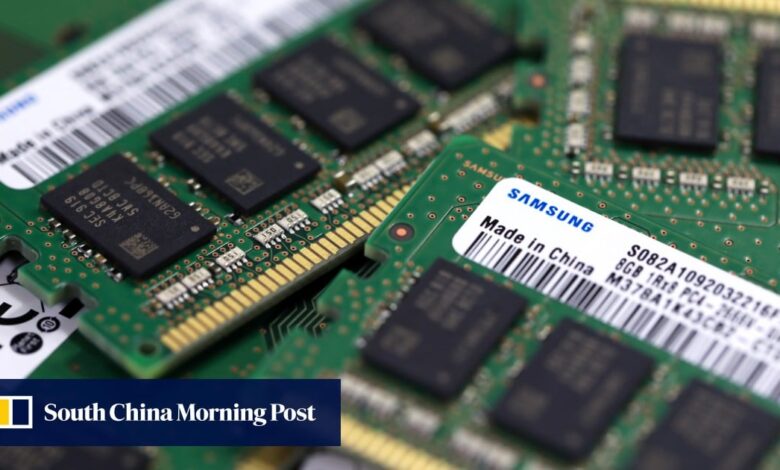Samsung shares trail rival SK Hynix as the smaller South Korean memory chip maker gets a boost from AI fever

[ad_1]
SK Hynix has surged 67 per cent this year thanks to its deal to supply premium high-bandwidth memory chips to Nvidia, trouncing Samsung, which is up 24 per cent as it struggles to get its HBM offering off the ground. That gap may widen further judging by options data, which show the put-to-call ratio on Samsung more than double that of SK Hynix.
The AI battle is pitched against the backdrop of weak global demand for the companies’ traditional memory products. That’s due in large part to smartphones, which are mired in what could be the worst industrywide slump in over a decade, hurting another key source of revenue for Samsung.
US waiver of tech restrictions to Samsung, Hynix handicaps China’s chip makers
US waiver of tech restrictions to Samsung, Hynix handicaps China’s chip makers
Chips remain hot overall thanks to the surge in demand for products needed to power generative AI services like ChatGPT. The Philadelphia Semiconductor Index up 31 per cent this year, outpacing gains in nearly any benchmark you can think of.
So after years of leading the memory industry, Samsung is now seen needing to play catch-up in HBM, an advanced technology optimised to work with AI accelerators. HBM features a stack of DRAM that sits on top of a processor instead of being housed in a separate memory module, enabling faster data transfer.
SK Hynix – more of a “pure-play” memory maker than its diversified peer – was able to get a jump on the latest generation of the chip, winning Nvidia as a customer for its HBM3. Samsung reportedly had trouble finalising a contract with the US AI giant for its offering, though it has developed a new HBM3E chip and said it plans to introduce an HBM4 by 2025.
“This is a really unfamiliar scene”, with Samsung falling behind SK Hynix in HBM development, said Yoon Joonwon, a fund manager at DS Asset Management Co. “Everyone is focused on AI as that’s the only area where we see strong demand.”
Yoon sees securing a client such as Nvidia or Advanced Micro Devices as key for Samsung’s share price. Other observers point to yield, the amount of good chips it can produce from each batch of material, as the main thing for investors to monitor.
Such points will be closely watched for by analysts in the companies’ earnings reports later this month. Samsung’s recently released preliminary results showed a more modest slide in quarterly profit. Both companies have a similar amount of buy ratings and no sells, according to Bloomberg-compiled data. However, consensus price targets for Samsung indicate a gain more than 30 per cent from its current level over the next 12 months, compared with around 20 per cent for SK Hynix.
For market watchers like Lee Seung-Woo, an analyst at Eugene Investment & Securities, potential for change in AI leadership is possible further down the road, but it won’t be quick.
“Samsung won’t be staying behind forever,” said Lee, who rates the company a buy. “Samsung will likely start shipping the next version of HBM3 within this year, which will reduce the gap to about four to five months. SK Hynix will continue to maintain its lead, but Samsung will be able to reduce the gap next year.”
[ad_2]
Source link


